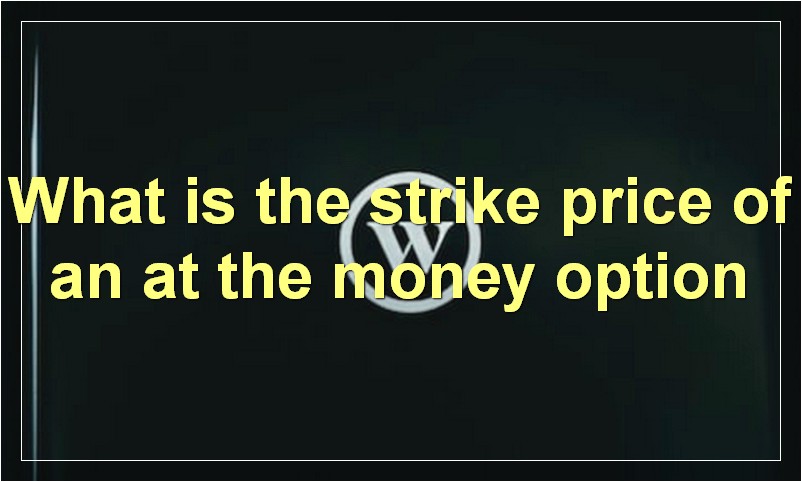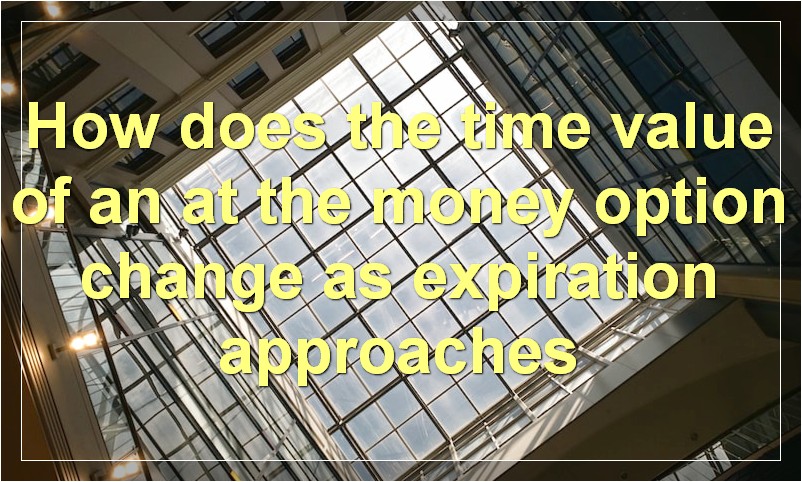If you’re thinking about investing in at the money options, you need to read this first.
What is an at the money option
An at the money option is an option whose strike price is equal to the underlying asset’s spot price. For example, if XYZ stock is trading at $100 per share, then an at the money XYZ call option would have a strike price of $100. At the money options are used as a way to hedge against portfolios, since they will offset any gains or losses in the underlying asset.
At the money options are popular among traders because they offer limited risk and a known downside. If the underlying asset does not move as expected, the option will simply expire worthless. However, if the underlying asset does move in the desired direction, the option will increase in value.
While at the money options offer limited risk, they also have limited upside potential. This is because the option’s strike price is already equal to the underlying asset’s spot price. As a result, the option can only increase in value if the underlying asset increases in value.
Overall, at the money options are a good way to hedge against portfolios and limit risk. However, traders should be aware of their limited upside potential before entering into any positions.
What is the strike price of an at the money option

The strike price of an at the money option is the price at which the underlying asset is trading when the option is purchased. This is important because it determines how much profit or loss the option holder will make if they exercise their option. For example, if a stock is trading at $50 per share and an at the money call option has a strike price of $50, the option holder will make a profit of $0 if they exercise their option. However, if the stock price rises to $51 per share, the option holder will make a profit of $1 per share.
What is the difference between an at the money call option and an at the money put option
An at the money call option is an option where the strike price is equal to the underlying asset’s current price. This means that if the underlying asset’s price increases, the option will increase in value as well. An at the money put option is an option where the strike price is again equal to the underlying asset’s current price. However, this time if the underlying asset’s price decreases, the option will increase in value.
What is the premium of an at the money option
When discussing options, the term premium refers to the price of the option. The premium of an at the money option is the price of the option with the strike price equal to the current price of the underlying asset.
How does the premium of an at the money option change as expiration approaches
As expiration approaches, the premium of an at the money option changes in a few ways. The most important factor is time decay, or theta. Theta is the rate at which options lose their value as they approach expiration. At the money options are more sensitive to time decay than out of the money or in the money options because they have less time value. This is because their intrinsic value is equal to the underlying asset price, so they can only decline in value.
Another factor that affects at the money options’ premiums as expiration approaches is implied volatility. Implied volatility is a measure of how much the market expects the underlying asset to move. When implied volatility is high, it means that the market expects the asset to move a lot, so at the money options will be more expensive. When implied volatility is low, it means that the market expects the asset to move less, so at the money options will be less expensive.
One last factor that can affect at the money options’ premiums as expiration approaches is interest rates. If interest rates are high, it will cost more to carry an at the money option position because you will have to pay more interest on your margin account. If interest rates are low, it will cost less to carry an at the money option position because you will have to pay less interest on your margin account.
How does the time value of an at the money option change as expiration approaches

As expiration approaches, the time value of an at the money option changes in a few ways. First, as expiration nears, the extrinsic value or time value of the option decreases. This is because there is less time remaining until expiration for the underlying asset to move enough to make the option profitable. Second, as expiration approaches and the time value decreases, the option’s Delta (a measure of how much the option price will change for a given change in the underlying asset price) also changes. For at the money options, Delta will approach 0.5 as expiration nears. This means that for every dollar move in the underlying asset price, the option price will move 50 cents. Lastly, Theta (a measure of how much time decay affects the option price) will increase as expiration approaches. This is due to there being less time remaining until expiration for the underlying asset to move enough to make the option profitable.
What is the intrinsic value of an at the money option
An at the money option is an option with an exercise price equal to the underlying asset’s current market price. The intrinsic value of an at the money option is the difference between the market price of the underlying asset and the strike price of the option. If the market price of the underlying asset is greater than the strike price, then the option has intrinsic value; if the market price is less than the strike price, then the option does not have intrinsic value.
What is the relationship between strike price and intrinsic value for at the money options
The relationship between strike price and intrinsic value for at the money options is quite simple. The intrinsic value is the difference between the strike price and the current market price. If the current market price is lower than the strike price, then the option has no intrinsic value.
How does implied volatility affect the price of at the money options
As the expiration of an at-the-money option approaches, the option’s premium will generally increase as the implied volatility of the underlying asset increases. This is because options that are closer to expiration are more sensitive to changes in the underlying asset’s price. When the underlying asset’s price is more volatile, the option’s premium will increase to compensate for the increased risk.
What are some trading strategies involving at the money options
There are a few different trading strategies that can be used when trading at the money options. One strategy is to buy at the money call options and put options. Another strategy is to use a straddle, which is when you buy both a call option and a put option. A third strategy is to use a strangle, which is when you buy a call option and a put option with different strike prices.

